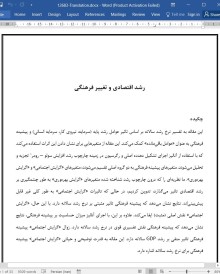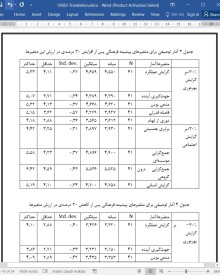
دانلود مقاله رشد اقتصادی و تغییر فرهنگی
چکیده
این مقاله به تفسیر نرخ رشد سالانه بر اساس تاثیر عوامل رشد پایه (سرمایه، نیروی کار، سرمایه انسانی) و پیشینه فرهنگی به عنوان «عوامل باقیمانده» کمک میکند. این مقاله از متغیرهایی برای نشان دادن این اثرات استفاده میکند که با استفاده از آنالیز اجزای تشکیل دهنده اصلی و رگرسیون در زمینه چارچوب رشد افزایش سولو – رومر تجزیه و تحلیل میشوند. متغیرهای پیشینه فرهنگی به دو گروه اصلی تقسیم میشوند: متغیرهای «گرایش اجتماعی» و «گرایش بهرهوری». ما نظریهای را که درون چارچوب رشد شناخته شده متغیرهای «گرایش بهرهوری» به طور چشمگیری بر رشد اقتصادی تاثیر میگذارد، تدوین کردیم، در حالی که تاثیرات «گرایش اجتماعی» به طور کلی غیر قابل پیشبینیاند. نتایج نشان میدهد که پیشینه فرهنگی تاثیر مثبتی بر نرخ رشد سالانه دارد. با این حال، «گرایش اجتماعی» نقش اصلی (مثبت) ایفا میکند. علاوه بر این، با اجرای آنالیز میزان حساسیت بر پیشینه فرهنگی، نتایج نشان میدهد که پیشینه فرهنگی نقش تفسیری قوی در نرخ رشد سالانه دارد. زوال «گرایش اجتماعی» پیشینه فرهنگی تاثیر منفی بر رشد GDP سالانه دارد. این مقاله به قدرت توضیحی و حیاتی «گرایش اجتماعی» پیشینه فرهنگی برای نرخ رشد سالانه اشاره دارد.
5. نتیجهگیری
این مقاله سعی دارد تا پیشینه فرهنگی را به عنوان بخشی از «عوامل باقیمانده» در فرآیند رشدی که با سرمایه، نیروی کار و عوامل سرمایه انسانی در چارچوب نظریه رشد کامل، فراتر از تابع رشد تقویت شده رومر – لوکاس، آنالیز کند. این مقاله پیشینه فرهنگی را به دو گروه اصلی متغیر تقسیم کرده است: جنبههای پیشینه فرهنگی جوامع «گرایش بهرهوری» و «گرایش و اجتماعی». تا حد زیادی، این مقاله در برجسته کردن اهمیت پیشینه فرهنگی در تفسیر نرخ رشد GDP در تابع رشد تقویت شده سولو – رومر پایه موفق بوده است. برای رسیدن به این مسئله، ما به این متغیرها اجازه دادیم تا با عوامل رشد پایه همکاری کنند. عوامل متناوب و ترویج دهنده نرخ رشد سالانه با شفافیت قابل توجهی تعریف میشوند تا اهمیتی که بهبود شرایط خاص رشد بر نحوه شکلگیری نرخ رشد دارد را برجسته کند.
نتایج تجربی تاثیر عوامل رشد پایه بر نرخ رشد سالانه GDP را تایید میکنند. با توجه به تاثیرات میان رشد اقتصادی و فرهنگ، یک رابطه یک طرفه شکل میگیرد، زیرا ظن مشکلات درونزا تایید نشده است. پیشینه فرهنگی «گرایش اجتماعی» جوامع به طور مثبتی بر نرخ رشد سالانه GDP میگذارد. تاثیر متغیرهای «گرایش اجتماعی» توسط هیچ گونه متغیر توضیحی دیگر (سرمایه، نیروی کار، سرمایه انسانی) دریافت نمیشود، در تضاد با متغیرهای «گرایش بهرهوری» که تاثیر آنها بر عملکرد اقتصادی، به دلیل ماهیت آنها، ممکن است در تاثیر بقیه متغیرهای تحقیق گنجانده شده باشد. بنابراین، پیشینه فرهنگی «گرایش اجتماعی» در جوامع ممکن است عنصر تقویت کننده برای رشد طولانی مدت اقتصاد باشد، و این عوامل «گرایش اجتماعی» مطمئنا از طریق مداخلات سیاستی قابل ارتقا هستند. با این حال، این موضوع پیچیده بوده و تاکنون به طور کامل مورد بررسی قرار نگرفته است.
Abstract
The paper contributes to the interpretation of annual growth rates based on the effect of the basic growth factors (capital, labour, human capital) and the cultural background as part of the “remaining factors”. It uses a series of variables to express these effects, which are analysed with a principal component analysis and a regression analysis, in the context of a Solow–Romer augmented growth framework. Cultural background variables are divided in two main groups: “Efficiency Orientation” and “Social Orientation” variables. We formulate the hypothesis that within the well-known growth framework “Efficiency Orientation” variables significantly affect economic growth, while “Social Orientation” influences are unpredicted in principle. The results confirm that cultural background positively affects annual growth rates. However, “Social Orientation” plays the main (positive) role. Furthermore, performing a sensitivity analysis on the cultural background, the conclusions confirm that cultural background has a strong interpretive role in annual growth rates. The deterioration of the “Social Orientation” cultural background negatively affects annual GDP growth. The paper points the crucial explanatory power of the “Social Orientation” cultural background for annual growth rates.
5. Conclusions
This paper attempts to analyse cultural background as part of the “remaining factors” in the growth process that cooperate with the capital, labour and human capital factors in the framework of a complete growth theory, beyond the Romer-Lucas augmented growth function. The paper divides the cultural background into two main groups of variables: the “Efficiency Orientation” and the “Social Orientation” aspects of the cultural background of societies.
To a great degree,this paper succeeds in highlighting the importance of cultural background in interpreting GDP growth rates within the basic Solow–Romer augmented growth function. To achieve this, we allowed these variables to cooperate with the basic growth factors. The interceptive and promoting factors of annual growth rates are defined with considerable clarity to highlightthe importance thatthe improvement ofthe special conditions of growth would have in the way the growth rates are formed.
The empirical results confirm the effect of the basic growth factors on annual GDP growth rates. Regarding the effects between culture and economic growth, an one way relationship accrues, as suspicions for endogeneity problems are not confirmed. The “Social Orientation” cultural background of the societies positively affects annual GDP growth rates. The effects of the “Social Orientation” variables are not captured by any other explanatory variables (capital, labour, human capital), in contrast with the “Efficiency Orientation” variables, whose effect on economic function, due to their nature, may be included in the effect of the rest of the research variables. Thus, the “Social Orientation” cultural background in societies may be a reinforcing element for long-run economic growth, and these “Social Orientation” factors certainly can be promoted by policy interventions. However, the issue is quite complex and has not been thoroughly investigated to date.
چکیده
1. مقدمه
2. پیشینه نظری و متغیرهای مورد استفاده
2.1 کمک و چارچوب نظری «عوامل باقیمانده»
2.2 شکلگیری پیشینه فرهنگی
2.3 نقش فرهنگ در رشد
2.4ددادهها
3. روش مورد استفاده و نتایج تجربی
4 .کار تجربی و بحث در مورد نتایج
4.1 مدل پایه
4.2 آنالیز حساسیت
5 .نتیجهگیری
منابع
ABSRACT
1. Introduction
2. The theoretical background and the variables used
2.1. The contribution and theoretical construction of the “remaining factors”
2.2. The formation of cultural background
2.3. The role of culture in growth
2.4. The data
3. The methodology employed and the empirical results
4. Empirical work and discussion of the results
4.1. The basic model
4.2. Sensitivity analysis
5. Conclusions
References
- اصل مقاله انگلیسی با فرمت ورد (word) با قابلیت ویرایش
- ترجمه فارسی مقاله با فرمت ورد (word) با قابلیت ویرایش، بدون آرم سایت ای ترجمه
- ترجمه فارسی مقاله با فرمت pdf، بدون آرم سایت ای ترجمه



